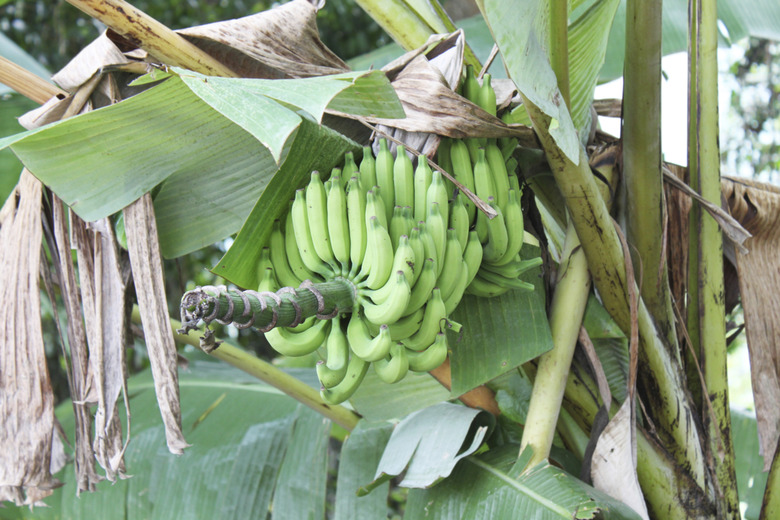How To Care For Banana Trees To Get Bananas
We may receive a commission on purchases made from links.
If you already have a banana tree (Musa acuminata) growing in your yard, but have yet to see it produce any fruit, be patient. As tropical plants that grow in U.S. Department of Agriculture plant hardiness zones 10 and 11, bananas typically produce their flowers about 10 to 15 months after first emerging from the ground, though it can take longer if you don't properly care for the plants. If you live outside the banana plant's limited frost-free hardiness range, don't expect a harvest of bananas; instead, grow this tropical plant as an ornamental in your landscape.
The first three to four months of the plant's life will determine how much it produces. To give it the right care, pay special attention to fertilizer and water, as well as the growth habits of your banana.
Banana Fruit Growth
Banana Fruit Growth
The flowering stalk where the bananas grow comes out of the center of the pseudostem. You'll typically notice it when the plant has 26 to 32 leaves. A spiral of flowers grow along the flowering stalk, and fleshy bracts cover the flowers and eventually fall off. The fruit develops in clusters that are called hands. It can take anywhere from 80 to 180 days from shoot to harvest depending on the cultivar and growing conditions.
Growing Conditions for Banana Trees
Growing Conditions for Banana Trees
Bananas grow well in a fertile soil that is moist but not waterlogged. The plants also prefer full sun, but they can handle some shade. A tree growing in shady conditions tends to take longer for bananas to grow and develop. Wind protection is also helpful as too much wind can shred and dry the leaves.
Fertilizer Needs for Banana Plants
Fertilizer Needs for Banana Plants
Fertilize each young plant with 1/2 pound of 6-2-12 fertilizer every 60 days. When the flowers and the purple-colored bracts emerge, increase this in 1/2-pound increments until you're giving the plants 5 pounds of fertilizer throughout the flowering cycle.
Adequate Water for Banana Plants
Adequate Water for Banana Plants
Unless you give them just the right amount of water, banana plants won't thrive. Bananas don't fare well in soggy soil, and tend to fruit slowly if they're not getting enough water. To strike a balance, provide about 1 to 1 1/2 inches of water each week.
To check that the soil drains adequately, dig a post hole 2 feet deep in the area where your bananas are planted. Fill the hole with water and check how much drains away after two hours. If the water isn't gone, consider installing a drainage system, such as an underground pipe with holes, to carry away excess moisture.
Pruning for Good Growth
Pruning for Good Growth
If you have a banana plant, you'll likely end up with more than just one. Bananas send out underground rhizomes that force new shoots up, creating the potential for having a full banana grove within a few years. Because all of those plants are connected, cutting some back will allow one to focus on flowering.
Ideally, you'll have three plants growing in one area at a time, removing all others. Leave one alone and allow it to flower. Cut another one back to one-half of the largest one's size, and cut the third down short, between 6 inches and 3 feet, depending on the size of the others. When the large one flowers and produces fruit, cut that one back to the ground, because it has finished producing fruit. Wipe the blades of your pruning tools with a cloth soaked in rubbing alcohol to prevent the spread of disease.
Keep Weeds Away
Keep Weeds Away
For the best success in flowering and fruiting, don't crowd your bananas. If your plants are small, they can be planted as close as 8 feet from other small banana plants, while large ones should be 12 feet from others.
Keep weeds at bay, pulling them up as soon as you see them. Placing mulch around the plants will help prevent other growth from stealing nutrients from your banana plants. Also try placing finished compost under the banana's canopy to give your plants even more nutrients.
Common Problems With Banana Trees
Common Problems With Banana Trees
Two common problems for bananas include fusarium wilt and sigatoka disease. There's no known control for fusarium wilt, also called Panama disease, besides avoiding growing bananas in areas known to be infested with the fungus. If your plants have it, their leaves will wilt and turn yellow and the stalk might look brown or black and slimy.
For yellow sigatoka disease, you might see pale green or brown spots on the plants leaves. For black sigatoka, you might see reddish-brown spots on the lower portions of the leaves. Both fungi will eventually entirely cover the leaves and kill them. If you see this problem, cut off all leaves infected with more than 50 percent of spots and completely remove them from the garden area to avoid spreading the disease. In general, careful fertilizer applications and good drainage are your best allies, and fungicide is typically not necessary in home gardens.
